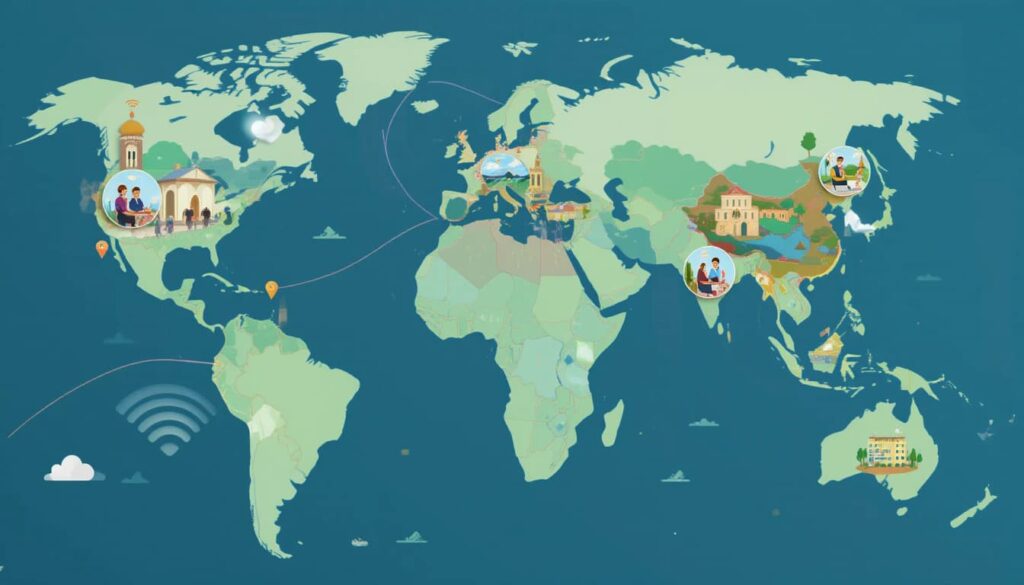The traditional 9-to-5 office setup is undergoing a massive transformation. The rise of remote work worldwide has become one of the most significant changes in the global workforce in recent years. Thanks to the pandemic where a large number of people started working from home. With the help of technology, this shift became easier. Today, remote jobs are a permanent part of business strategy for companies and career plans for professionals.
Let’s explore the current remote work trends, benefits, challenges, and how businesses and employees can thrive in a remote-first world.
1. The Remote Work Revolution: How It All Started

The shift towards remote work was already in motion before COVID-19. However, the pandemic accelerated adoption across all industries. Millions of workers suddenly started working from home, and businesses discovered that productivity didn’t necessarily depend on physical presence.
Now, companies like Google, Amazon, and Facebook are embracing hybrid or fully remote work models. These business and work models have proven that location-independent work is here to stay.
2. Remote Work Statistics You Should Know (2024)

To understand the scale of this shift, consider these remote work statistics:
- Over 58% of the global workforce now works remotely at least once a week.
- Businesses that allow remote or hybrid work options often experience a noticeable drop (up to 25%) in staff turnover.
- Insights from Owl Labs’ State of Remote Work Report reveal that businesses offering remote flexibility see 25% less employee turnover.
According to industry trends, online searches for remote job opportunities have surged more than 300% since 2020. This shift indicates that remote work has evolved from a luxury into a standard professional requirement.
3. Top Benefits of Remote Work

Both employees and employers are reaping the benefits of this new work culture.
For Employees:
- Work-life balance improves with reduced commuting time.
- Access to global job opportunities regardless of location.
- Cost savings on transportation, meals, and office attire.
- Increased autonomy and flexibility in managing tasks.
For Employers:
- Access to a global talent pool.
- Reduced overhead costs (office space, utilities, supplies).
- Improved employee satisfaction and retention.
- Enhanced productivity in many remote-friendly roles.
4. Remote Work Tools & Technologies

Thanks to modern tech, managing remote teams is easier than ever.
Popular tools enabling remote work success:
- Communication: Slack, Microsoft Teams, Zoom
- Project Management: Trello, Asana, Notion
- Time Tracking: Toggl, Hubstaff
- Collaboration: Google Workspace, Miro, Figma
Such tools close the gap between in-person and virtual work environments.
5. Top Countries Embracing Remote Work

Remote work isn’t limited to Silicon Valley. Many nations are actively supporting the trend through policy changes and digital infrastructure. According to Forbes’ Guide to Remote Work Visas, countries like Estonia and Portugal are leading the way in offering digital nomad visas.
Top remote work-friendly countries:
- Estonia: Among the best destinations for remote workers, Estonia stands out with its dedicated Digital Nomad Visa program.
- Portugal: Lisbon continues to attract remote professionals and digital nomads with its vibrant lifestyle and remote-friendly policies.
- Germany & Netherlands: Great infrastructure and remote job opportunities.
- United States & Canada: High demand for tech and remote roles. USA & Canada: These countries remain top choices for tech-savvy professionals due to the abundance of remote job opportunities.
6. Popular Remote Job Roles in 2025

As highlighted in UNCTAD’s report on remote job roles, an increasing number of roles like software development and digital marketing are now being successfully carried out remotely, reflecting the growing shift toward location-independent careers. Websites like We Work Remotely, Remote.co, and FlexJobs are great starting points to explore remote job opportunities.
Looking to start your remote career? These roles are in high demand:
- Software Developers
- Digital Marketers
- Virtual Assistants
- Content Writers
- Customer Support Representatives
- Data Analysts
- UX/UI Designers
7. Remote Work Challenges and How to Overcome Them
While remote work has numerous advantages, it also comes with its own set of challenges.
Common issues:
- Feelings of isolation or loneliness
- Communication gaps between team members
- Difficulty in managing time and distractions
- Blurred work-life boundaries
Solutions:
- Schedule virtual check-ins and social calls
- Use time-blocking techniques to stay organized
- Set up a dedicated workspace at home
- Prioritize mental health and daily routines
Many remote workers struggle with distractions and time management. Explore our expert-curated guide on the best productivity apps for remote workers in 2025 to maximize efficiency. Managing productivity remains a challenge, as highlighted by the U.S. Bureau of Labor Statistics on remote work productivity, emphasizing the need for effective time management strategies.
8. Future of Remote Work: What’s Next?

The future of work is hybrid, remote, and global. Companies are expected to continue investing in remote-first infrastructure, digital training, and policies that support long-term flexibility.
Trends to watch:
- AI-powered remote work tools
- Virtual reality (VR) meetings
- Decentralized work platforms
- Workation and digital nomad-friendly countries
Remote work is not just a trend but a fundamental shift in the working models of businesses. The World Economic Forum’s Future of Jobs Report 2023 predicts that AI-powered tools and decentralized work platforms will significantly shape the future workplace.
Conclusion
The rise of remote work worldwide has transformed how we live, work, and connect. Whether you’re a job seeker, business owner, or freelancer, embracing this evolution offers countless opportunities for growth and freedom. As technology continues to empower virtual collaboration, the boundaries of the workplace will continue to expand. If you haven’t already, now is the perfect time to explore the remote work lifestyle and discover the freedom and flexibility it offers.


6 replies on “The Rise of Remote Work Worldwide”